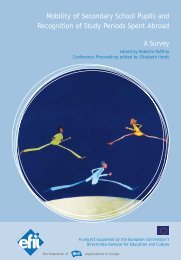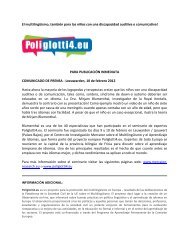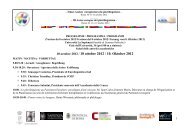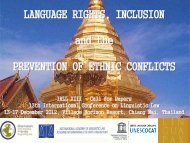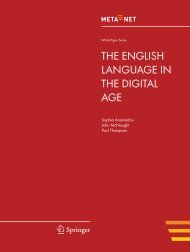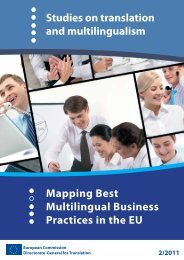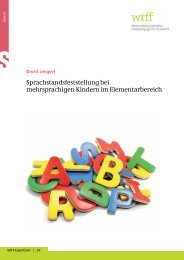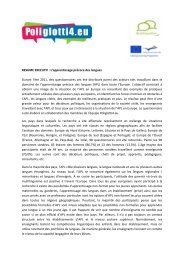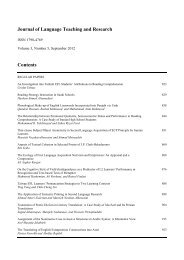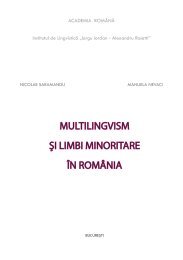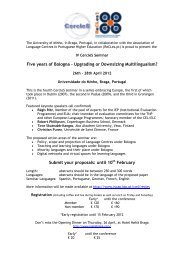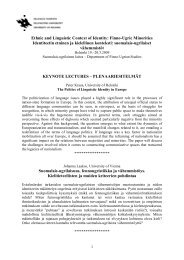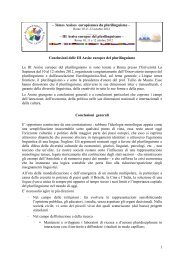FULL VERSION - European Commission - Europa
FULL VERSION - European Commission - Europa
FULL VERSION - European Commission - Europa
Create successful ePaper yourself
Turn your PDF publications into a flip-book with our unique Google optimized e-Paper software.
WORKING GROUP ON TRANSLATION AND TERMINOLOGYGroup Members’ Position PapersContribution from EEU/<strong>European</strong> Esperanto UnionTraduttore, traditore?Translation is difficult to appreciate in the abstract – most consideration of this ‘most difficultof arts’ 41 quickly leads us to specific problems in translating between two specific languages.The present note looks very briefly at the situation regarding translation to and fromEsperanto.Esperanto and Translation – some little-known factsThough original literature in Esperanto is now more extensive than translations 42 , theShakespearean scholars, Janton and Tonkin, tell us that 43“… at least 10,000 literary works have been translated into Esperanto … theseconstitute the largest anthology of world culture ever undertaken for popularconsumption. … Through Esperanto translation, several masterpieces of little-knownor minority cultures have gained a worldwide audience and reached levels of societynormally indifferent to foreign literatures.”Nagy 2007, for instance, lists 622 translations by 78 translators from Romanian to Esperanto,and literary anthologies translated from most major languages, and many minor ones, havebeen published in Esperanto 44 . Auld 1991 contains poetry translated from 73 languages. Buttranslation flows in both directions: for instance, McKay 2009 contains English, ScottishGaelic and Scots versions of William Auld’s magnum opus La Infana Raso (The Infant Race),which had already been published in Portuguese, Polish, Dutch, French and Hungariantranslations. Oeste, Becker, Cherpillod, de Diego, Richmond and Schulze deal with otheraspects of translation. Janton 1989 draws our attention to a fact that is often overlooked:"... translators into Esperanto enjoy a unique advantage over translators into ethniclanguages because they translate from their own vernacular whereas the reverse isthe rule with translators into ethnic idioms. … Thus Esperanto acts as a bridgebetween cultures. It is the Esperanto version of Marta that has been translated intoChinese and Japanese. … Only a Finn could give to the Kalevala that fidelity down tothe last syllable that the translator Johan Leppäkoski provides." 45Much Croatian and Hungarian literature, for instance, has been translated into Esperanto,and thence to Chinese and Japanese, thus creating a real cultural bridge. To give just oneexample of the potential of Esperanto: the concept behind the Italian traduttore, traditore(the translator is a traitor) is not easily expressed in other languages in two words, and istherefore normally quoted in Italian. Auld, however, produces a brilliant Esperanto version,traduko, trukado, 46 where the brevity of the original is not only maintained, but surpassed,and the letters used in both words are identical. Shakespeare’s Hamlet has been translated41Auld 1986: 91.42Valén 2004: 81; Sutton 2008: 2.43Janton and Tonkin 1993: 93, 94, xii.44Many are listed at http://katalogo.uea.org/katalogo.php?kateg=antl.45Janton 1989: 213; Janton and Tonkin 1993: 94-95.46Auld 1986: 104. The meaning of traduko is obvious; trukado comes from the verb truki (related to French truc, plus the suffix–ad, signifying duration)Civil Society Platform on Multilingualism 73APPENDIX to Policy Recommendations06/06/2011 – FINAL <strong>VERSION</strong>



